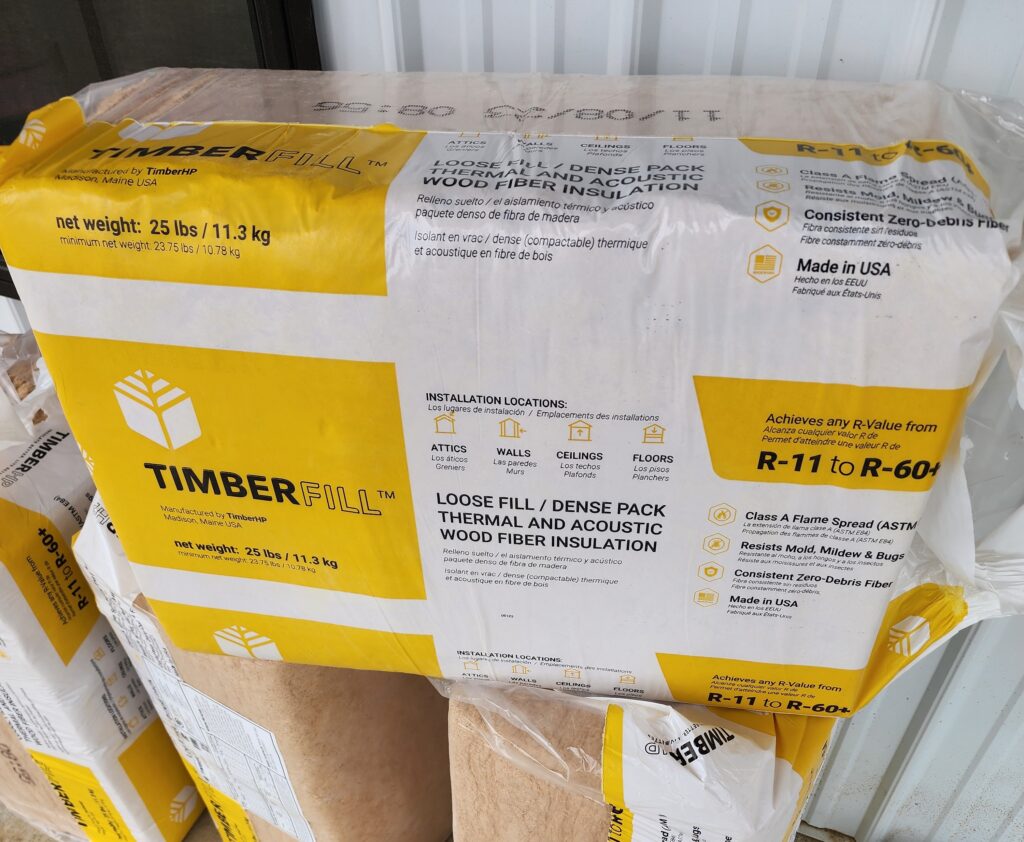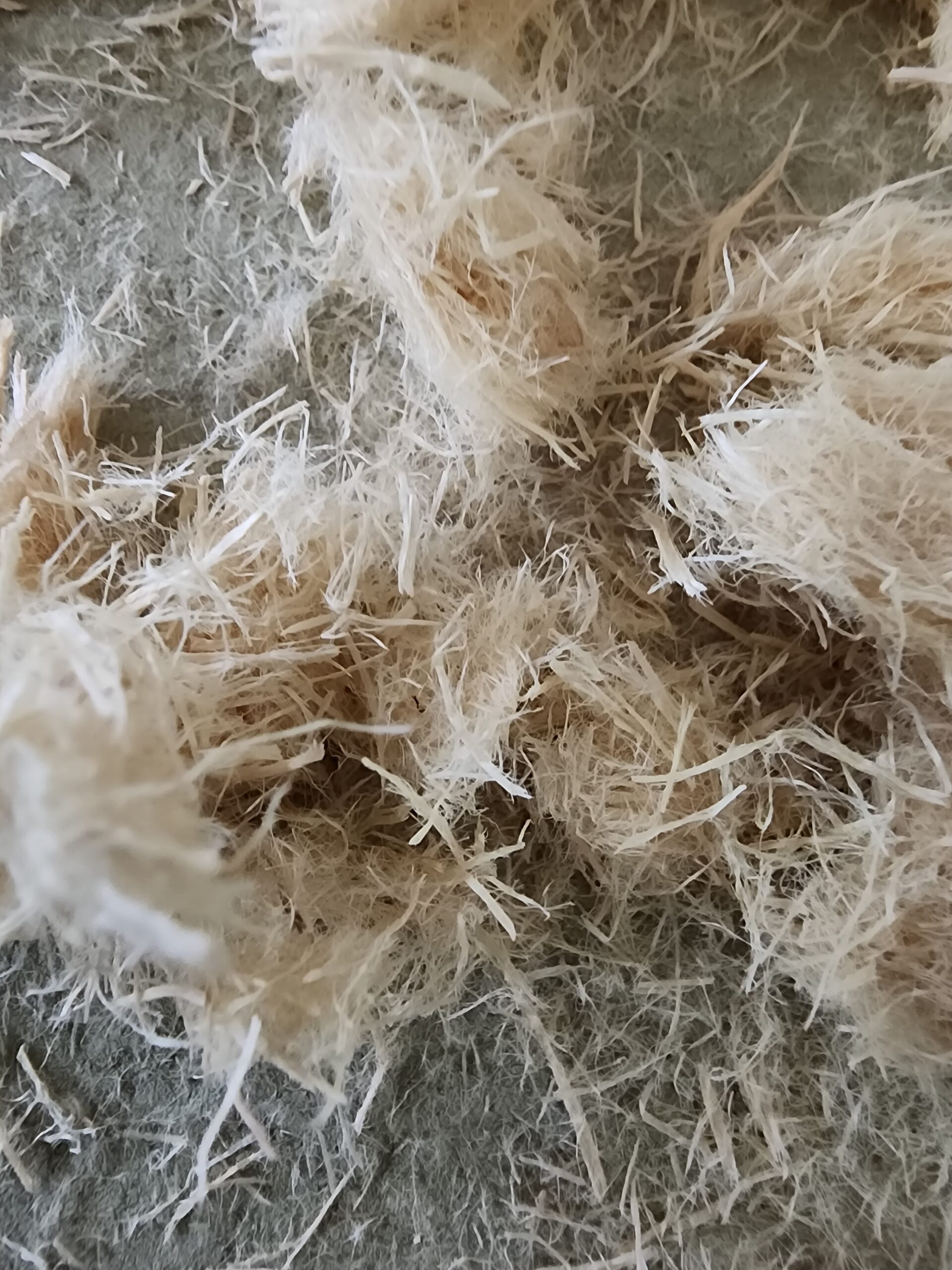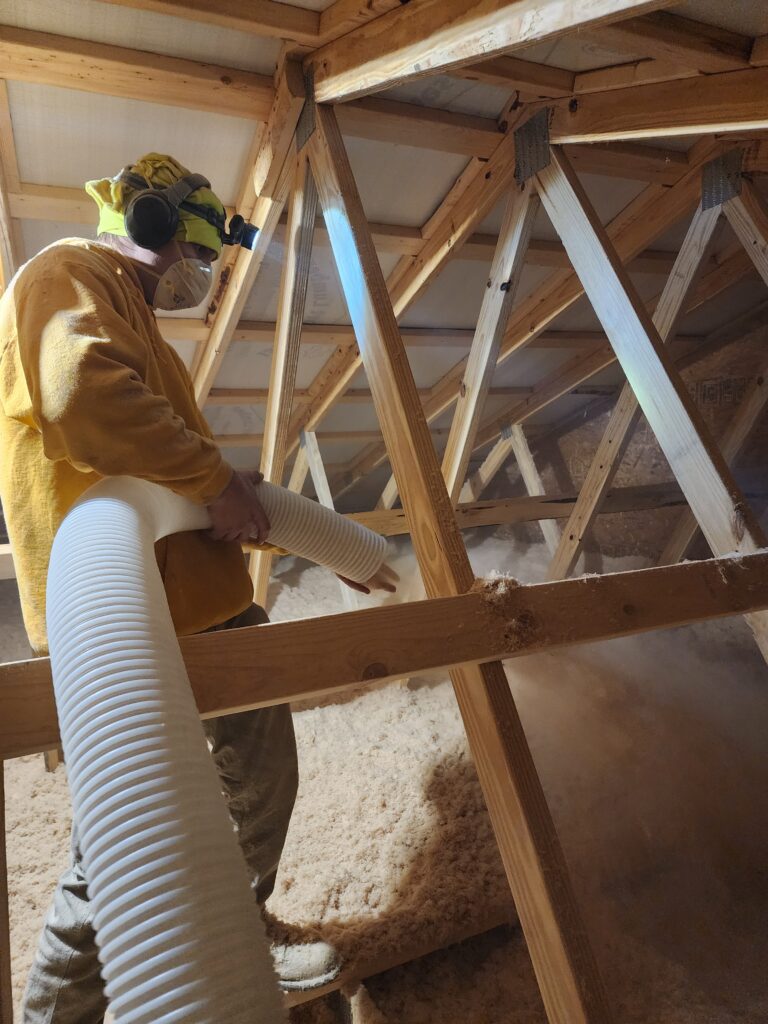How is Wood Fiber Insulation Made to be Rot & Fire Resistant?
By Randy Williams

Recently, I was invited to a BS and Beer meeting (BS stands for Building Science) at a home under construction near Kansas City, MO. The meeting featured an installation demonstration of TimberHP’s TimberFill wood fiber insulation. This new loose-fill wood fiber insulation was being blown into the attic and dense packed into the walls. Two representatives from TimberHP, Business Development Manager Dan Edelman and Field Education Specialist Matt Damon were on hand to answer any questions and teach the installing contractor the best practices for installing the TimberHP’s loose fill insulation. Being a new product, there were many questions during the BS and Beer meeting. The most common where:
Doesn’t wood fiber burn?
What happens if the insulation gets wet?
How do you keep bugs from destroying the product?
Lucky for Dan and Matt, all three questions are answered the same, the product uses borate. So, what is borate?
Borate is a chemical compound containing boron, oxygen, and/or several other combinations of elements or compounds, such as salt. The element, boron is number 5 on the periodic table of elements. It was officially discovered in 1808, but the element is not naturally occurring on earth, it is always found combined with other chemicals. Borax, or sodium borate is a mineral containing boron and is often mined at dry lakebeds scattered around the globe. Borax is used in several household cleaning and laundry products, (some of us that are older have probably heard of the product 20 Mule Team Borax). Borax can be mixed with other compounds to create a flux for welding and soldering and it has been used as a food additive, but several countries now prohibit this use, including the United States.
Boric acid, another material containing boron, is a compound of boron, oxygen, and hydrogen that can be used as an antiseptic, in swimming pools as a pH buffer, and in agriculture to prevent boron deficiencies in plants.
There are many other uses for boron compounds, but we in the construction industry are mostly interested in its use as a fire retardant, wood preservative, and for pest control. I recently reached out to TimberHP to find out more information on which borate chemistry they use. Jason Todd, TimberHP’s Director of Building Science and Industry Support replied:
“We’ve chosen disodium octaborate tetrahydrate (D.O.T.), as a premium borate that costs a bit more than other options but works well partially due to its solubility and effectiveness. Compared to traditional newspaper cellulose, we can apply around half as much borate to our products with exceptional results, because we liquify and inject a borate solution on the way to the dryer for both TimberFill and TimberBatt. With our application, the borates bind to the surface of the wood fiber, if not absorbed into it, and our fire resistance is exceptional and consistent because of this.”


When disodium octaborate tetrahydrate is exposed to a flame, it releases boric oxide which acts as a barrier between the TimberFill insulation and the fire, preventing the fire from spreading. TimberFill meets the ASTM E84 requirements for a Class A rated insulation product, as a matter of fact, using either the TimberFill or the soon to be released TimberBatt products can add 15 minutes to a fire resistive rated wall assembly.
DOT also works as a wood preservative by reducing fungi and algae development on the surface of the wood-based insulation. ASTM C739 is the testing standard for cellulosic fiber loose-fill insulation, including ground wood stock (TimberFill). Testing includes the materials characteristics for corrosiveness, critical radiant flux, fungi resistance, moisture vapor sorption, odor emission, smoldering combustion, and thermal resistance.
Borates have been used for decades to control termites, carpenter ants along with a few other wood eating insects. TimberFill and TimberBatt do not claim their borate treatment is an insecticide. The EPA’s Federal Insecticide, Fungicide, and Rodenticide Act (FIFRA) rules regulate that no insulation product can claim its product will reduce or eliminate insect damage without testing and registering. At this time, there isn’t a plan for insecticide testing. Given the known characteristics of borate, it would be my guess that there is at least some protection against insect infestation.
D.O.T. is a fairly benign chemical, safe for humans to work with. The data safety sheet says if nose or throat irritations are experienced, move to fresh air. If eye contact occurs, flush with water. If eye irritation persists for more than 30 minutes, seek medical attention. Skin contact is only an issue if the skin is severely damaged before exposure. Ingesting small levels of the chemical (less than one teaspoon) will not harm a healthy adult. Large quantities that are ingested require medical attention and monitoring (hopefully no one is eating TimberFill). Working with TimberFill and TimberBatt products will only require basic personal protective equipment, eye protection and a basic respirator. You still may want to cover exposed skin and wear gloves, all of which are recommended no matter what construction duties are being performed.
I’ve had the opportunity to work with a few different loose fill insulation products throughout my career, blowing both cellulose and fiberglass in attics. I have developed a sensitivity to fiberglass fibers, short exposures have me coughing and hacking. Blowing cellulose will create a lot of hanging dust, I have experienced not being able to see across a small attic during the dusty installations. Watching the TimberFill attic insulation being blown in the Kansas City project, I was surprised by how little dust was created, and the dust that was hanging during the application would clear quickly when the insulation blower was turned off.

Matt’s comment
The most common issue with blowing TimberFill is the setting up of the insulation blower. Settings that would normally be fine for cellulose will need to be adjusted for TimberFill. Slightly opening the gate and adding a little more air pressure helps prevent clogging. Using a needle (a smaller metal pipe that fits on the end of the plastic blowing hose) during dense packing will help deliver the insulation to the top and bottom of the cavity without the need for feeding a floppy hose to those areas. The Kansas City crews had a few issues with clogging, but they were using older hoses that needed some maintenance. Duct tapping the butt ends of two hoses together without the use of a coupling will create a pinch point for the material to build up and eventually clog. This also occurs when blowing cellulose. The recommended density when blowing TimberFill into walls is 3 lbs. More information on installing TimberFill can be found in our downloadable installation guide.
Many of us don’t do deep dives into what’s in the products we use when building and working on homes. With the increased attention given to indoor air quality and the health of both the occupants and crews working with the different building materials, it’s refreshing to see there are companies producing new products that have their finger on the pulse of our industry. In my opinion, TimberHP is one of those companies.